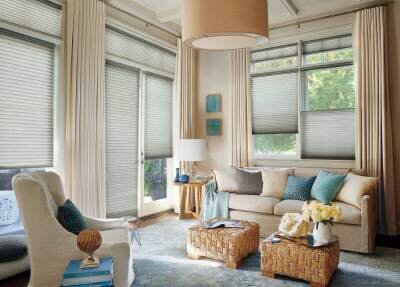Not sure which Blinds and Drapery to buy?
CONTACT US & WE CAN HELP YOU!
Blinds & Drapery
When you need to be able to control the amount of light that enters a room or adjust your level of privacy, blinds and drapes are both ideal solutions. However, just as with so many other things today, there are more choices than ever when it comes to your window coverings.
Keeping it simple by considering the basics is the best way to go about choosing any kind of blinds or drapery for your home.
Where You Are Installing Them
One factor that will have a direct effect on the type of blinds or drapery you choose is the type of room they are installed in. For example, you likely won’t need blackout blinds or drapery in your kitchen but would benefit from them in a bedroom.
The same is true if you have small children; you may wish to opt for cordless, motorized blinds in places like bedrooms and living areas where small children spend a lot of their time. A craft room may benefit most from lots of natural light, whereas a dining room’s diffused light with sheer drapery may be best.
Your Windows
Although you may not think much about them, your home’s windows have several aspects that can help you determine which type of blinds or drapery is best. For instance, if one set of windows is exposed to direct sunlight for most of the day, you may want a window covering that can protect your carpeting and furniture from fading, such as UV-treated Douglas blinds.
If your windows look out into your carefully landscaped backyard or another inspiring view, then you’ll want to ensure the window covering you choose allows you to see as much of that view as possible.
Choosing Blinds
There are five basic types of blinds. Each has its benefits and disadvantages, all of which should be carefully considered before purchasing.
Fabric Blinds
Fabric blinds allow soft, filtered light through windows, as well as provide privacy. They are also ideal as an accessory in terms of room decor, as they are available in a wide range of patterns and colors. Fabric blinds can be difficult to install on your own and can be more expensive than other blind types.
Real and Faux Wood Blinds
Real wood has a rich and lustrous appearance and can add much warmth to a room when stained to showcase its natural colors. When painted, real wood blinds can suit nearly any style of the room.
Real wood blinds are durable but can be prone to nicks and dents, and so shouldn’t be placed in rooms where they are vulnerable to potential impact damage. Because real wood blinds will expand and contract in response to moisture levels in the air, they are not suited to rooms that are perpetually cold or high in moisture.
Faux wood blinds offer the same benefits in terms of appearance and ability to match decor as their real wood counterparts do. However, they are not prone to moisture damage like real wood blinds tend to be. Hunter Douglas window blinds in faux wood can also cost less than real wood blinds and are lighter in weight as well.
Aluminum Blinds
Aluminum blinds are still a popular choice for homeowners. Not only are they inexpensive, but aluminum blinds are wider than mini blinds. However, they do make noise when lowered and raised and, so, maybe suited to noisy areas, such as on a garage entry door or den.
These blinds are less expensive than both real and faux wood blinds and can work in a wide variety of rooms with the right decorative accents.
Mini Blinds
Mini blinds represent the least expensive of all blind types. Made of PVC, mini blinds are manufactured in virtually every color, and their lightweight makes them easy to install. Despite these advantages, mini blinds can be difficult to clean, especially as they age. They are also more easily damaged than aluminum blinds.
Features
Today’s selection of modern blinds can come complete with many features. Some products can be treated or be manufactured with UV-blocking features. Others can work as heat exchanges, keeping warm air in or transferring it outside, depending on the season.
Choosing Drapery
You’ll need to consider where your drapery will be installed, as well as the kind of light your windows receive or what view they offer.
Fabric Type
If you want to install drapes in a formal dining or music room, for example, you can add a lot of class with velvet or silk instead of Hunter Douglas blinds shades. Of course, it may be a more economical option to choose equally elegant linen, rayon, or cotton blends, which can work with virtually any decor.
Which Color Works Best?
Finding the right color means making a decision about what your drapes will do. Do you want them to be a focal point of the room? If so, then choose drapery in a bold shade. If you’d rather they blend with your decor, choose drapes that are a few shades darker than the color of your walls.
There are no hard and fast rules with color, however; you can go as dramatic, subtle, or elegant as you like; anything goes!
Length of Time
How long you plan to keep your drapery is definitely something to consider because drapery can get expensive. If you’re the type of homeowner who likes to change things up on a regular basis, it may make sense to purchase lower-cost drapes so that you’re not spending a bundle every few months or years. On the other hand, expensive drapery can be moved around from room to room, allowing you to redecorate other areas without having to spend a large amount.
Deciding on a Pattern
It’s generally best to stick with drapery in a solid color if there is a prominent pattern in the room (such as a rug or furniture). Otherwise, it may clash. When doing this, try choosing a common color that can be found in several areas of the room you plan to hang your drapes in if you’re not choosing products from Hunter Douglas retailers.
If the rest of the room is in solid colors, drapery can add texture when it contains small neutral prints like paisley or dots. You can also make drapery the center of attention by opting for a bold color or pattern.
Width
Drapery should look ample, not stretched when closed. The combined width of your drapery should be 2 to 2.5 times the width of your window. This can be reduced to 1.5 times window width if the drapes are never closed, like when they’re being used only to accent the sides of a window.
Measuring for Blinds
You can get an accurate measurement by measuring the height and width of your windows at least twice. If installing blinds inside a window casing, you should also measure the depth of your window. If installing outside a window casing, you can ensure complete window coverage by adding at least two inches for overlap on each side of the window.
Measuring for Drapes
Because there are so many ways that drapes can be hung, you may get many different measurements. For example, if you want to make a window look taller, you’ll want to mount the curtain rod between 4 and 6 inches above your window frame. If you prefer to make a window appear taller, then you’ll need to be able to extend the rod between 3 and 6 inches beyond your window frame.
Valance or Rod Type
The valance or rod-type you choose can also make a difference to how your Hunter Douglas door blinds or drapery look. There are many decorative valance and curtain rod options on the market. The best way to choose is to look at the style of your room and match the valance or rod to it.
Installation
Regardless of whether you choose blinds or drapes, it can help to have professional installation assistance. Curtains may take as little as 10 minutes to install per window, whereas blinds can be more complicated, depending on their style and how they are operated.
At the end of the day, both curtains and blinds can be stylish and functional ways to add some elegance, warmth, and drama to your decor.




